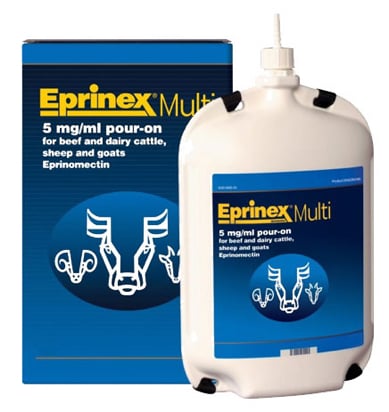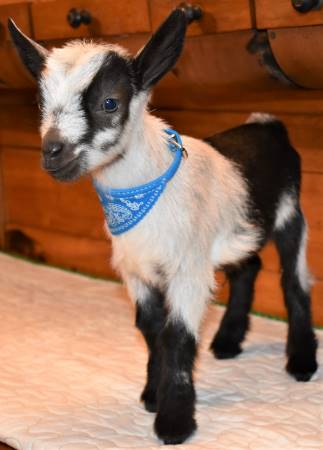Mites
This information is provided by the Oklahoma State University Extension
| Mites: | Late fall through early winter & spring is the time typically to watch for signs of mites. |
|---|
Goats can be infested by several species of mites, but the species more commonly found on goats are goat follicle mite (Demodex caprae), scabies mite (Sarcoptes scabiei), psoroptic ear mite (Psoroptes cuniculi), and chorioptic scab mite (Chorioptes bovis)
- The goat follicle mite causes dermal papules and nodules, and the resulting condition is known as demodectic mange in goats. These papules or nodules are caused by hair follicles or gland ducts becoming obstructed and producing these swellings, trapping the mites within these lesions. These continue to enlarge as the mites multiply, sometimes reaching several thousand mites per lesion. Cases of demodectic mange occur most commonly in young animals, pregnant does and dairy goats. Papules usually appear on the face, neck, axillary region or udder and these papules can enlarge to 4 cm in diameter as mites multiply. Nodules can rupture and exude the mites, resulting in transmission of the mite to other animals. Transmission of the goat follicle mite to newborn goats typically occurs within the first day following birth. Other possible means of transfer are licking and close contact during mingling or mating.
- The scabies mite burrows into the skin of its host, causing varying degrees of dermatitis, a condition known as sarcoptic mange. Although cases of sarcoptic mange in goats often resolve themselves without developing severe signs, heavily infested goats may exhibit crusty lesions and extensive hair loss around the muzzle, eyes, and ears; lesions on the inner thighs extending to the hocks, brisket, underside and axillary region; dermal thickening and wrinkling on the scrotum and ears; and dry, scaly skin on all parts of the body, especially in areas of hair loss.
- The psoroptic ear mite or ear mange mite causes lesions on or in the ear of the host animal. These lesions cause crust formation, foul odor discharges in the external ear canal and behavioral responses such as scratching the ears, head shaking, loss of equilibrium and spasmodic contractions of neck muscles. Psoroptic ear mite lives its entire life under the margins of scabs formed at infested sites. The eggs are deposited and hatch in four days. The complete life cycle takes about three weeks. All stages of this nonburrowing mite pierce the outer skin layer. Transmission of this mite occurs between animals by direct contact. Prevalence rates as high as 90 percent in the U.S. have been reported in dairy goats, including both kids and adults. Goats usually less than one year old generally exhibit higher infestation rates than do older animals. Signs of the psoroptic ear mite in kids are often observed as early as three weeks after birth, reflecting transfer of mites from mother to young. By six weeks of age, most kids in infested goat herds are likely to harbor these mites. Chronic infestations can lead to anemia and weight loss in goats.
- The chorioptic scab mite causes chorioptic mange in domestic animals, especially in cattle, sheep, goats and horses. This mite occurs primarily on the legs and feet of its hosts, where all of the developmental stages are likely to be found. Eggs are deposited singly at the rate of one egg per day. Eggs are attached with a sticky substance to the host skin. Adult females usually live for two weeks or more, producing about 14 eggs to 20 eggs during this time. Eggs hatch in four days, and are often clustered as multiple females lay their eggs in common sites. The immature stages last anywhere from 11 days to 14 days and the entire life cycle is completed in three weeks. Infestations of chorioptic scab mite tend to be higher in goats than in sheep, with up to 80 percent to 90 percent of goats in individual herds being parasitized. The mites occur most commonly on the forefeet of goats, where the largest numbers of mites and lesions are usually associated with the accessory claws. However, they also can occur higher on the foot. Lesions are generally mild and seldom draw attention.
More about Chorioptic Mange in Goats:
-
It is most likely to see these parasites infest goats during the autumn/fall, winter and early spring,
HERE WE WILL CONSIDER THE CHORIOPTES MITE WHICH CAUSES CHORIOPTIC MANGE.
Credit for the following information goes to Merck Veterinary Manual & ScienceDirect.
-
At AppleJo Farms we have been using a different product for a few years now, at the encouragement of a Vet. It has several benefits & has proven effective.
-
Eprinex pour-on.
Lice
| Lice: | Late fall through late spring is the typical season for lice in goats.. |
|---|
Lice (Order: Phthiraptera) are wingless, flattened, permanent ectoparasites of birds and mammals. The development of lice is slightly different when compared to other external parasites. They go through incomplete development, where the immatures are known as nymphs and look similar to adults (Figure 1). More than 3,000 species have been described, mainly parasites of birds. Lice infest a wide range of domestic livestock, including pigs, cattle, goats and sheep, causing a chronic dermatitis (pediculosis), characterized by constant irritation, itching, rubbing and biting of the hair or fleece. Goat lice are host specific and only attack goats and their close relatives such as sheep.
Lice are divided into two main groups: the Anoplura (sucking lice) and Mallophaga (chewing or biting lice). Biting lice have chewing mouthparts and feed on particles of hair, scabs and skin exudations. Sucking lice pierce the host’s skin and draw blood. Louse-infested animals may be recognized by their dull, matted coat or excessive scratching and grooming behavior. The irritation from louse feeding causes animals to rub and scratch, causing raw areas on the skin or loss of hair. Weight loss may occur as a result of nervousness and improper nutrition. Milk production is reduced up to 25 percent. Also, the host is often listless and in severe cases, loss of blood to sucking lice can lead to anemia.
Lice are generally transmitted from one animal to another by contact.
Treatment of Mites & Lice in Goats
For Treatment and Control of Internal and External Parasites: Eprinex
NOTE : This is a Beef & Dairy cattle product FDA approved and available with no prescription. If you use it for goats and sheep you are using it off-label. It is your responsibility to consult your Vet.
Dosage: Some suggest using it at the rate of 1cc/20lbs in a syringe with no needle dribbling along the back line from neck to tail- directly on the skin for the control and effective removal of Biting lice and other external parasites.
NOTE: Even though this is also a dewormer, it has not yet been proven effective on all types of parasites. You will still need to deworm your goats for internal parasites.


Eprinex Pour-On: A broad-spectrum parasite control product. Backed by Merial's Satisfaction Guarantee! EPRINEX is weatherproof and has no meat withdrawal or milk withholding. Apply along back onto skin.
MODE OF ACTION: How it works
Eprinomectin is a member of the macrocyclic lactone class of endectocides which have a unique mode of action. Compounds of the class bind selectively and with high affinity to glutamate-gated chloride ion channels which occur in invertebrate nerve and muscle cells.
This leads to an increase in the permeability of the cell membrane to chloride ions with hyperpoloarization of the nerve or muscle cell, resulting in paralysis and death of the parasite. Compounds of this class may also interact with other ligand-gated chloride channels, such as those gated by the neurotransmitter gamma-aminobutyric acid (GABA).
The margin of safety for compounds of this class is attributable to the fact that mammals do not have glutamate-gated chloride channels, the macrocyclic lactones have a low affinity for other mammalian ligand-gated chloride channels and they do not readily cross the blood-brain barrier.
Sores & Scabs Treatment
In severe cases, you may see your goat itching especially its legs and loss of hair around the eyes and ears and legs especially. They can itch and bite so much that the goat gets sores and scabs.
What to do:
3 Steps for treatment as follows.
1. Treat with Eprinex
2. Treat sores and scabs on legs and also apply to the inside of the goats ears, a product called: Nu-Stock Wound Cream.
3. Re-treat with Eprinex in 3 weeks. Only when you see the hair growing back, discontinue treatment every 3 weeks with Eprinex.
Dosage for goats is double what it is for cattle--use this chart:
|
EPRINEX Pour-On Dose Guide for Goats |
||||
|
Goat weighing 5-10 lbs needs 1/2 ML Eprinex topical applied onto skin, along spine Goat weighing 11-15 lbs needs 1 ML Eprinex topical onto skin, along spine Goat weighing 16-22 lbs needs 2 ML Eprinex topical onto skin, along spine Goat weighing 23-32 lbs needs 2.5 ML Eprinex topical applied onto skin, along spine Goat weighing 33-42 lbs needs 3 ML Eprinex topical onto skin, along spine Goat weighing 43-63 lbs needs 3.5 ML Eprinex topical onto skin, along spine Goat weighing 64-84 lbs needs 4 ML Eprinex topical onto skin, along spine |
||||
Nu-Stock Wound Cream
- Non-toxic and safe for all animals
- For proven relief of red mange, ringworm, ear mites, cuts, scrapes and much more on dogs, cattle, goats and horses
- All-purpose topical
- Heals skin from inside out
- Helps regrow hair on old wounds
- Will begin to give animal almost immediate relief from discomfort of parasite infestation.
- Depending upon severity of wounds, reapply daily for 3-5 days
-
Pierce's All Purpose Nu-Stock Ointment, 12 Ounces each, 2 Tubes may be purchased from Amazon by using the following link: https://amzn.to/3RRX09q
- https://amzn.to/3SnkzXJ
ProBios Gel (OR Goat's Preferred Probiotic gel, OR Jump Start Microbial gel - they are all basically the same thing)
https://www.valleyvet.com/ct_detail.html?pgguid=A2343BF1-6AB2-4573-8731-3BF809BD6136
- https://amzn.to/3SnkzXJ

Additional note about Eprinex: (vetsurgeon.org) states: Eprinex is effective against the adult stages of the major gutworm species affecting sheep and goats and the lungworm Dictyocaulus filaria. I am currently dealing with a goat with lungworm and lice so perhaps Eprinex treatment will clear both up! I will let you know what I find.



Powered by Boutique Store Builder . Web Design by Avalon Rose Design.



